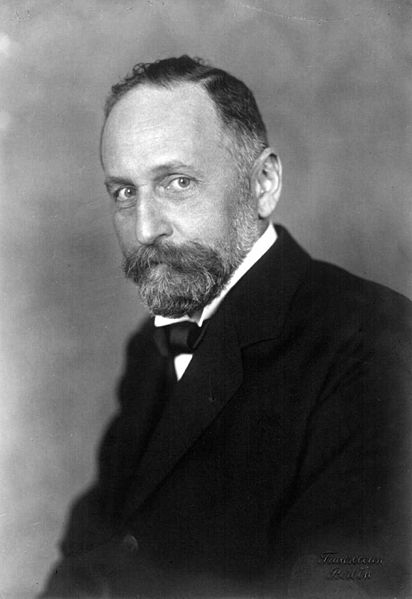<Back to Index>
- Chemist Richard Martin Willstätter, 1872
- Writer Vladimir Fyodorovich Odoevsky, 1803
- Diplomat Heinrich, count von Brühl, 1700
PAGE SPONSOR

Richard Martin Willstätter (13 August 1872 – 3 August 1942) was a German organic chemist whose study of the structure of plant pigments, chlorophyll included, won him the 1915 Nobel Prize for Chemistry. Willstätter invented paper chromatography independently of Mikhail Tsvet.
Willstätter was born into a Jewish family in Karlsruhe. He went to school there and, when his family moved, he attended the Technical School in Nuremberg. At age 18 he entered the University of Munich to study science and stayed for the next fifteen years. He was in the Department of Chemistry, first as a student of Adolf von Baeyer - he received his doctorate in 1894 - then as a faculty member. His doctoral thesis was on the structure of cocaine. Willstätter continued his research into other alkaloids and synthesized several of them. In 1896 he was named Lecturer and in 1902 Professor extraordinarius (professor without a chair).
In 1905 he left Munich to become professor at the ETH Zürich and there he worked on the plant pigment chlorophyll. He determined its structure. In 1912 he became professor of chemistry at the University of Berlin and director of the Kaiser Wilhelm Institute for Chemistry, studying the structure of pigments of flowers and fruits. In 1916 he returned to Munich as the successor to his mentor Baeyer. During the 1920s Willstätter investigated the mechanisms of enzyme reactions and did much to establish that enzymes are chemical substances, not biological organisms.
In 1924 Willstätter's career came to "a tragic end when, as a gesture against increasing antisemitism, he announced his retirement." According to his Nobel biography: "Expressions of confidence by the Faculty, by his students and by the Minister failed to shake the fifty-three year old scientist in his decision to resign. He lived on in retirement in Munich.... Dazzling offers both at home and abroad were alike rejected by him."
In 1938 Willstätter emigrated to Switzerland. He spent the last three years of his life there in Muralto near Locarno writing his autobiography. He died of a heart attack in 1942. Willstätter's autobiography, Aus meinem Leben, was not published in German until 1949. It was translated into English as From My Life in 1965.
In 1911 the fledgling American chemist Michael Heidelberger went to work for a year with Willstätter in Zurich. Willstätter helped his American student by sharing the cost of laboratory supplies with him, arranging that when expensive materials, such as silver nitrate, were to be bought, it was his turn to pay, while Heidelberger took turns buying cheaper materials like sulfuric acid. "Better training than that you couldn't have," Heidelberger summed up his experience with Willstätter. They remained friends for life.